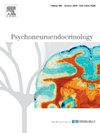Low anti-Müllerian hormone mediates the association between childhood trauma and PTSD in women but not in men
IF 3.4
2区 医学
Q2 ENDOCRINOLOGY & METABOLISM
引用次数: 0
Abstract
Women experience differential risk for childhood trauma and posttraumatic stress disorder (PTSD) when compared to men. Recent research has indicated lasting effects of childhood trauma across the lifespan and a bidirectional relationship between gonadal hormones like anti-Müllerian hormone (AMH) and PTSD that may help explain sex differences in PTSD. However, there is little data to support this hypothesized relationship, the potential direction of this relationship, or its effect in women and men across a large age range. The current study utilized a lifespan approach to examine the association between childhood trauma exposure and adulthood levels of AMH and PTSD symptoms. The current sample included 68 trauma-exposed veteran and non-veteran women (n = 27) and men (n = 41) aged 18–50 with clinical interview, self-report, and blood serum data, including 31 (47.0 %) participants with subthreshold-to-full PTSD. Adult trauma-exposed women had lower AMH levels (M=3.27 sqrt ng/mL) compared to trauma-exposed men (M=8.64 sqrt ng/mL; Hedge’s g=1.26). Overall, sex was a critical moderator of the association between AMH and PTSD, demonstrating significant AMH-related effects for women but not for men. To evaluate the potential developmental impact of childhood trauma and bidirectional relationship between AMH and lifetime PTSD symptoms, two moderated mediation analyses were conducted, examining sex as the moderator and 1) AMH and 2) PTSD symptoms as alternative mediators. AMH levels (Indirect Effect β=.391) mediated the relationship between childhood trauma and lifetime PTSD symptom severity for women but not for men. Alternatively, lifetime PTSD symptoms did not significantly mediate the relationship between childhood trauma and AMH levels. Findings from this small trauma-exposed cohort offer preliminary evidence that links developmental exposures to premature gonadal dysfunction and stress pathophysiology across the lifespan, revealing a potentially unidirectional relationship in which greater childhood trauma exposure is associated with reduced AMH levels in adult women and may confer greater lifetime PTSD symptom severity.
低抗勒氏激素介导儿童创伤和创伤后应激障碍之间的关联,但在男性中没有
与男性相比,女性患童年创伤和创伤后应激障碍(PTSD)的风险有所不同。最近的研究表明,童年创伤的持续影响贯穿一生,性腺激素如抗勒氏激素(AMH)和创伤后应激障碍之间存在双向关系,这可能有助于解释创伤后应激障碍的性别差异。然而,几乎没有数据支持这种假设的关系,这种关系的潜在方向,或者它在大年龄段的女性和男性中的影响。目前的研究利用寿命方法来检查童年创伤暴露与成年AMH和PTSD症状水平之间的关系。目前的样本包括68名创伤暴露的退伍军人和非退伍军人女性(n = 27)和男性(n = 41),年龄在18-50岁,具有临床访谈,自我报告和血清数据,其中包括31名(47.0 %)患有亚阈值至完全PTSD的参与者。成年创伤暴露女性AMH水平(M=3.27 sqrt ng/mL)低于创伤暴露男性(M=8.64 sqrt ng/mL;对冲的g = 1.26)。总的来说,性别是AMH和创伤后应激障碍之间关系的关键调节因素,显示出AMH对女性的显著影响,而对男性则没有。为了评估儿童创伤的潜在发展影响以及AMH与终生PTSD症状之间的双向关系,我们进行了两项有调节的中介分析,研究性别是调节因素,1)AMH和2)PTSD症状是替代中介因素。AMH水平(间接效应β=.391)介导了女性童年创伤和终生PTSD症状严重程度之间的关系,但对男性没有作用。另外,终生PTSD症状并没有显著调节童年创伤和AMH水平之间的关系。这个小型创伤暴露队列的研究结果提供了初步证据,表明发育暴露与性腺功能障碍和应激病理生理在整个生命周期中存在联系,揭示了一种潜在的单向关系,即童年创伤暴露程度越高,成年女性AMH水平越低,并可能导致终生PTSD症状的严重程度越高。
本文章由计算机程序翻译,如有差异,请以英文原文为准。
求助全文
约1分钟内获得全文
求助全文
来源期刊

Psychoneuroendocrinology
医学-精神病学
CiteScore
7.40
自引率
8.10%
发文量
268
审稿时长
66 days
期刊介绍:
Psychoneuroendocrinology publishes papers dealing with the interrelated disciplines of psychology, neurobiology, endocrinology, immunology, neurology, and psychiatry, with an emphasis on multidisciplinary studies aiming at integrating these disciplines in terms of either basic research or clinical implications. One of the main goals is to understand how a variety of psychobiological factors interact in the expression of the stress response as it relates to the development and/or maintenance of neuropsychiatric illnesses.
 求助内容:
求助内容: 应助结果提醒方式:
应助结果提醒方式:


